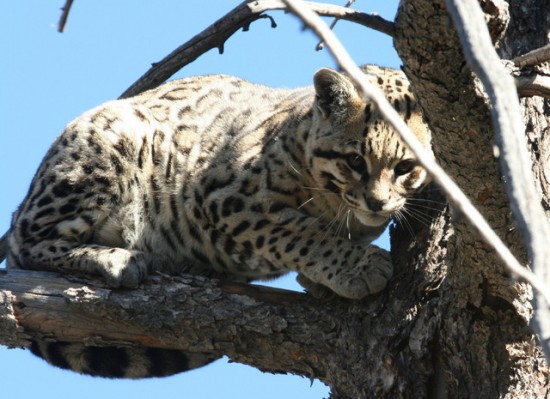When an Arizona man was working in his yard on Tuesday, he noticed his dog barking at a most unusual cat. The cat climbed a tree, and the man was able to get a closer look. It was about twice the size of a typical house cat. And its fancy markings were definitely not those of your standard kitty. The homeowner, who lives in southern Arizona’s Huachuca Mountains, called the state Game & Fish department.
The only other confirmed ocelot sighting in Arizona since 1964 was one that was run over by a car near Globe last year. The animal was believed to have escaped from captivity. Officials are reviewing photographs and scat samples from Tuesday’s site in southern Arizona to determine whether this ocelot was in its natural environment. If so, this is exciting news for conservationists. The cat appeared young, healthy and nonchalant, licking its paws in the tree, according to the wildlife officer. After he photographed the animal, it was left alone and eventually departed on its own, unharmed.

North American ocelot country: The Sky Islands region where Arizona, New Mexico, Texas and Mexico meet
Sky Island Alliance, a conservation organization dedicated to protecting the resources and wildlife of the Sky Islands region in Southeast Arizona and Northwest Mexico, has documented ocelots in northern Sonora, Mexico for the last three years in partnership with a local rancher. About 50 have been identified. In January 2010, they successfully photographed a jaguar in the same area, just 30 miles from the U.S. border — one year after the death of the last known jaguar in the U.S. For ocelots and jaguars to continue to live in the Sky Island region, wildlife migration corridors that link important habitat areas between Mexico and the United States must be protected, regardless of arbitrary political boundaries, according to the Alliance.
Though rare in the U.S., ocelots are thriving in the rainforests of Central and South America. They are very elusive, though the exceptionally fortunate visitor to places like Belize, Costa Rica, the Amazon or Brazil’s Pantanal might be rewarded with a sighting.
Learn more about them, and listen to an audio clip of their deep, rumbling voice here.
Here’s to exciting discoveries, in your own backyard and beyond!
Wendy

































